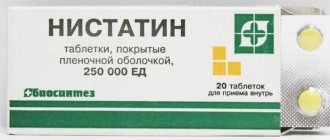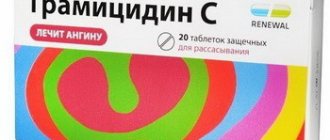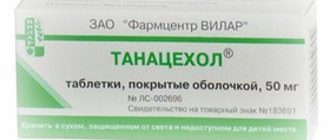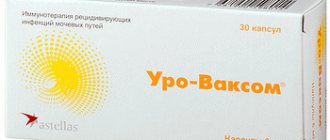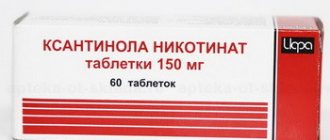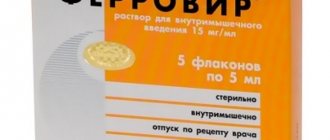Bral tablets are a combined drug that has antispasmodic, analgesic and anticholinergic therapeutic effects. They are used for pathogenetic and symptomatic treatment of pathological conditions accompanied by spasms of hollow organs. The use of the drug is excluded for pregnant women in the first trimester and in the last 6 weeks before childbirth, during lactation, as well as for children under 6 years of age.
Release form and composition
Dosage forms of Bral:
- solution for intravenous (IV) and intramuscular (IM) administration: transparent, yellowish liquid [5 ml in 1 dark glass ampoule, 5 ampoules in a cell package (pallet), 1 package (pallet) in a cardboard box ];
- tablets: flat, with beveled edges, round, light yellow in color, scored on one side and engraved with MICRO on the other (10 pcs per blister/strip, 1, 2 or 10 blisters/strips in a cardboard pack) .
Composition of 1 ml solution:
- active ingredients: fenpiverinium bromide – 0.02 mg; pitofenone hydrochloride – 2 mg; metamizole sodium (analgin) – 500 mg;
- additional components: water for injection, hydrochloric acid.
Composition of 1 tablet:
- active ingredients: fenpiverinium bromide – 0.1 mg; pitofenone hydrochloride – 5 mg; metamizole sodium (analgin) – 500 mg;
- additional components: corn starch (anhydrous), methylhydroxybenzoate, lactose, magnesium stearate, purified talc, povidone.
Took for headache treatment
Bral is a complex medicine that combines three active ingredients:
- Metamizole sodium (known as analgin) is a strong pain reliever;
- Pitophenone hydrochloride is an antispasmodic that affects the smooth muscles of blood vessels;
- Phenpiverinium bromide - acts similarly to the previous component.
Tablets I took for headaches are a combined analgesic and antispasmodic agent that has a complex effect on the causes of pain. Produced in India, it is the drug of choice for diseases associated with increased tone of the muscular lining of the arteries. The advantage of this medication is the ability to maintain optimal vascular lumen through the combination of two antispasmodics, which enhance the effect of use.
Pharmacological properties
Pharmacodynamics
Bral's composition includes: M-anticholinergic agent (fenpiverinium bromide), non-narcotic analgesic (metamizole sodium) and myotropic antispasmodic agent (pitofenone hydrochloride).
When these components are combined, a synergistic action occurs - a mutual enhancement of their pharmacological effectiveness:
- Metamizole sodium: has an analgesic, antipyretic and mild anti-inflammatory effect;
- pitofenone hydrochloride: relieves tension in the smooth muscles of internal organs, thanks to its inherent direct myotropic (papaverine-like) effect;
- fenpiverinium bromide: having an M-anticholinergic effect, it also helps relax smooth muscles.
Pharmacotherapeutic group
Metamizole sodium is a derivative of pyrazolone and exhibits analgesic, minor anti-inflammatory, and antipyretic activity. Pitofenone hydrochloride has a papaverine-like myotropic relaxing effect on smooth muscles. Fenpiverinium bromide has pronounced anticholinergic properties, reduces temperature and pain, and relieves smooth muscle spasms. The combined use of these three components leads to a mutual increase in their pharmacological effect on the body, an increase in antispasmodic and analgesic effects.
Indications for use
It is recommended for use for the relief of mild or moderate pain in the following conditions/diseases:
- spasms of smooth muscles of internal organs - postcholecystectomy syndrome, renal and biliary colic, biliary dyskinesia, spasm of the bladder and ureter, chronic colitis, intestinal colic, diseases of the pelvic organs, algodismenorrhea;
- sciatica, neuralgia, myalgia, arthralgia - with short-term symptomatic therapy;
- surgical interventions and diagnostic procedures - as an auxiliary medicine.
Contraindications
Absolute:
- tachyarrhythmias;
- chronic heart failure in the stage of decompensation;
- angina pectoris (stable and unstable);
- inhibition of bone marrow hematopoiesis;
- severe liver and/or kidney failure;
- megacolon and intestinal obstruction;
- deficiency of glucose-6-phosphate dehydrogenase;
- closed-angle form of glaucoma;
- acute intermittent porphyria;
- prostatic hyperplasia (occurring with clinical manifestations);
- collapse;
- pregnancy and lactation;
- age up to 5 years – for tablets; up to 3 months (or body weight less than 5 kg) - for solution;
- combined use with colloidal blood substitutes and radiopaque drugs;
- hypersensitivity to the components of the drug (including pyrazolone derivatives).
Relative (the drug must be used with caution):
- tendency to arterial hypotension;
- functional disorders of the liver and/or kidneys;
- bronchial asthma;
- predisposition to bronchospasm;
- age under 18 years;
- increased individual sensitivity to non-narcotic analgesics or non-steroidal anti-inflammatory drugs (including a history of the aspirin triad).
Causes of headaches
The occurrence of pain syndrome is associated with the influence of external and internal factors:
Internal factors for the appearance of headaches and somatic diseases:
- hypertension, coronary heart disease;
- diseases associated with cerebrovascular accidents and osteochondrosis of the cervical spine;
- tumors and associated cancer wasting;
- infectious and inflammatory diseases, including those with brain damage.
Proper treatment of headaches is based on identifying and eliminating the causes. If the headache is symptomatic and associated with stress, lack of sleep and fatigue, non-steroidal anti-inflammatory drugs and antispasmodics are indicated, which improve blood circulation in the brain and block pain impulses.
Read about the causes and types of headaches: primary, secondary, cranial.
Do you know why tension headaches occur and how to deal with them?
Directions for use and dosage
Solution
The solution is intended for intravenous and intramuscular administration.
When treating acute severe colic in adolescents over 15 years of age and adults, the drug is infused intravenously slowly in a dose of 2 ml (1 ml over 1 minute). If a repeated injection is necessary, the solution is administered intravenously after 6–8 hours. As a rule, with intravenous infusion, 2 ml of Bral is sufficient.
IM injections are carried out 2 times a day, 2 ml, the daily dose should be no more than 4 ml.
Recommended single doses for children and adolescents under 15 years of age, taking into account their body weight and age:
- 5–8 kg (or 3–11 months): IM – 0.1–0.2 ml (intravenous injections are prohibited);
- 9–15 kg (or 1–2 years): IM – 0.2–0.3 ml, IV – 0.1–0.2 ml;
- 16–23 kg (or 3–4 years): IM – 0.3–0.4 ml, IV – 0.2–0.3 ml;
- 24–30 kg (or 5–7 years): IM – 0.4–0.5 ml, IV – 0.3–0.4 ml;
- 31–45 kg (or 8–12 years): IM – 0.6–0.7 ml, IV – 0.5–0.6 ml;
- 46–53 kg (or 12–15 years): IM or IV – 0.8–1 ml.
If necessary, re-administration of Bral in the same doses is allowed. The drug should not be used parenterally for more than 5 days.
Before use, the solution must be warmed in your hand.
Bral is incompatible in the same syringe with other medications.
Pills
The tablets are taken orally after meals, without chewing or breaking, with a small amount of neutral liquid.
Recommended single doses Taken depending on the age of the patient, with a frequency of administration 2-3 times a day:
- 5–7 years: ½ tablet;
- 8–12 years: ¾ tablet;
- 13–15 years: 1 tablet;
- over 15 years: 1–2 tablets.
The maximum daily dose in adults is 6 tablets, the course of treatment is no more than 5 days.
You can increase the dose of the drug or increase the duration of use only after consulting your doctor.
Analogs
On the modern pharmaceutical market there are several structural analogues for Bral tablets.
Baralgetas
A combined drug that is prepared in the form of a solution for parenteral intravenous or intramuscular administration and tablets for oral administration. It is prescribed to reduce the severity of pain and spasms for children from 5 years of age, adults, as well as pregnant women in the second and third trimester. The drug is contraindicated for pregnant women in the first trimester, as well as during the last 6 weeks before childbirth and during lactation.
Baralgin
Combined drug in the form of tablets for oral administration. Used to reduce the intensity of pain, as well as the severity of spasms of various internal hollow organs in adults and adolescents over the age of 13 years. There is no data on the possibility of using the drug for pregnant women.
Maxigan
A remedy for spasm and pain, which is available in tablet form for oral use. It is intended for adults and children over 9 years of age. Prescription is not recommended for pregnant women, as well as in the presence of certain concomitant pathological conditions.
Side effects
- cardiovascular system: cyanosis, decreased blood pressure (BP);
- nervous system: dizziness; extremely rarely - headache;
- digestive system: in isolated cases – a burning sensation in the epigastric region;
- anticholinergic effects: tachycardia, extremely rarely - dry mouth, accommodation paresis, decreased sweating, difficulty urinating;
- hematopoietic system: with a long course - leukopenia, thrombocytopenia, agranulocytosis (stomatitis, difficulty swallowing, unmotivated rise in temperature, sore throat, chills, symptoms of proctitis/vaginitis may be observed);
- urinary system: rarely (when taking large doses or long-term use) - red staining of urine, oliguria, proteinuria, anuria, functional kidney disorders, interstitial nephritis;
- allergic and dermatological reactions: angioedema, itching, skin rash, urticaria (including on the mucous membrane of the nasopharynx and conjunctiva); extremely rarely - toxic epidermal necrolysis, malignant exudative erythema, anaphylactic shock;
- local reactions: with intramuscular injection - infiltrates at the injection site.
If there is a tendency to bronchospasm during therapy, an attack may develop.
Overdose
A significant excess of the recommended therapeutic dose of Bral tablets is accompanied by nausea, vomiting, a feeling of dry mouth, increased sweating, a pronounced decrease in the level of systemic blood pressure, and confusion.
Treatment of overdose is symptomatic; there is no specific antidote. If a short amount of time has passed after the overdose, then gastric and intestinal lavage and intestinal sorbents (activated carbon) are first prescribed. A person’s serious condition requires hospitalization in a medical hospital and constant monitoring of vital functions.
special instructions
With a long course of therapy (more than 7 days), it is necessary to monitor the functional state of the liver and peripheral blood parameters.
Bral is not recommended for use to relieve acute abdominal pain until the cause of its development is determined.
During the treatment period it is prohibited to drink alcohol.
The drug is used parenterally only in emergency situations, as well as when oral administration is impossible (including impaired absorption from the digestive tract).
Particular care must be taken when administering a solution in a dose of 2 ml or more due to a possible sharp decrease in blood pressure.
Intravenous injections should be carried out in a supine position, monitoring blood pressure, respiratory rate and heart rate.
For intramuscular injections, you need to use a long needle.
Impact on the ability to drive vehicles and complex mechanisms
During therapy, you should refrain from driving vehicles and other complex mechanisms due to the possible occurrence of dizziness.
Drug interactions
- codeine, propranolol, H2-histamine receptor blockers - the inactivation of metamizole sodium slows down, which leads to an increase in the Bral effect;
- allopurinol, oral contraceptives, tricyclic antidepressants - the toxicity of metamizole increases due to disruption of its metabolism in the liver;
- barbiturates, phenylbutazone and other inducers of microsomal liver enzymes - the effect of metamizole sodium is weakened;
- sedatives, tranquilizers - the analgesic effect of metamizole sodium is enhanced;
- cyclosporine – the level of its content in the blood decreases;
- cytostatics, thiamazole - the threat of developing leukopenia is aggravated;
- other non-narcotic analgesics, ethanol – mutual enhancement of effects is noted;
- phenothiazine derivatives (including chlorpromazine) – increases the likelihood of severe hyperthermia;
- amantadine, H1-histamine blockers, quinidine, butyrophenones, phenothiazines - the M-anticholinergic effect increases;
- glucocorticosteroids, indirect anticoagulants, oral antidiabetic agents, indomethacin - the severity of the action of these drugs increases.
I took the tablets - official instructions for use, analogues, price, availability in pharmacies
Each tablet contains:
| Active substances: | ||
| metamizole sodium | – | 500 mg |
| pitofenone hydrochloride | – | 5 mg |
| fenpiverinium bromide | – | 0.1 mg |
Excipients: lactose, corn starch (anhydrous), povidone, methylhydroxybenzoate, purified talc, magnesium stearate.
Description:
Pale yellow, round, flat tablets with beveled edges, scored on one side and engraved “MICRO” on the other side.
Pharmacotherapeutic group:
Analgesic (non-narcotic analgesic + antispasmodic)
ATX code : N02BB52
pharmachologic effect
Metamizole sodium (analgin) has an analgesic, antipyretic and weak anti-inflammatory effect.
Pitophenone hydrochloride, like papaverine, has a direct myotropic effect on the smooth muscles of internal organs and causes its relaxation.
Phenpiverinium bromide, due to its m-anticholinergic effect, has an additional antispasmodic effect on smooth muscles.
Indications for use
Pain syndrome due to spasms of smooth muscles of internal organs - renal and biliary colic, intestinal spasms, algodismenorrhea and other spastic conditions of internal organs, as well as headache and angina pain.
Can be used for short-term symptomatic treatment of arthralgia, neuralgia, sciatica, myalgia.
As an adjuvant it can be used to reduce pain after surgical and diagnostic interventions.
Contraindications
Hypersensitivity to pyrazolone derivatives (butadione) and other components of the drug; granulocytopenia, severe liver or kidney dysfunction; deficiency of glucose-6-phosphate dehydrogenase; Tachyari porphyria; closed-angle form of glaucoma; prostatic hyperplasia; intestinal obstruction and megacolon; diseases of the blood system; collapsed states; pregnancy (first trimester and last 6 weeks); lactation period; children's age (up to 5 years); increased individual sensitivity to non-steroidal anti-inflammatory drugs or non-narcotic analgesics.
Directions for use and doses
Adults and children over 15 years of age take orally (preferably after meals), usually 1-2 tablets 2-3 times a day. The daily dose should not exceed 6 tablets. Duration of treatment – no more than 5 days.
Increasing the daily dose of the drug or the duration of treatment is possible only under the supervision of a physician. Dosages for children. Give the drug to children only as prescribed by a doctor.
Dosage for children 5-7 years old – half a tablet, 8-12 years old – three quarters of a tablet, 13-15 years old – one tablet 2-3 times a day. Other dosage regimens are possible only after consultation with a doctor.
Side effect
In therapeutic doses, the drug is usually well tolerated. Sometimes allergic reactions are possible (skin rash, itching, very rarely - anaphylactic shock). In isolated cases - a burning sensation in the epigastric region, dry mouth, headache.
Possible dizziness, decreased blood pressure, tachycardia, cyanosis. With long-term use there are cases of blood system disorders (thrombocytopenia, leukopenia, agranulocytosis). If you are prone to bronchospasm, it is possible to provoke an attack.
In very rare cases - malignant exudative erythema (Stevens-Johnson syndrome), toxic epidermal necrolysis (Lyell's syndrome), decreased sweating, accommodation paresis, urinary retention.
Rarely (usually with long-term use or high doses) - renal dysfunction: oliguria, anuria, proteinuria, interstitial nephritis, red urine. All side effects should be reported to your doctor.
Carefully
The drug should be used with caution and under the supervision of a physician in patients with impaired liver or kidney function, or with a tendency to hypotension and bronchospasm. Children and adolescents (under 18 years of age) should use the drug only as prescribed by a doctor.
Overdose
Symptoms: vomiting, decreased blood pressure, drowsiness, confusion, nausea, pain in the epigastric region, impaired liver and kidney function, convulsions. Treatment: gastric lavage, administration of activated carbon, symptomatic therapy.
Interaction with other drugs
The simultaneous use of Bral® with other non-narcotic analgesics can lead to mutually enhanced effects. Tricyclic antidepressants, oral contraceptives, and allopurinol disrupt the metabolism of metamizole in the liver and increase its toxicity.
Barbiturates, phenylbutazone and other inducers of microsomal liver enzymes weaken the effect of metamizole sodium. Simultaneous use with cyclosporine reduces the level of the latter in the blood. Sedatives and tranquilizers enhance the analgesic effect of the drug. When used together with ethanol, the effects are mutually enhanced.
If it is necessary to use these and other medications simultaneously, you should consult your doctor.
special instructions
During treatment with the drug, you should not drink alcohol; It is not recommended to drive vehicles or engage in other potentially hazardous activities that require rapid physical and mental reaction. Use in nursing mothers requires cessation of breastfeeding. With long-term (more than 5 days) use of the drug, monitoring of the peripheral blood picture and the functional state of the liver is necessary.
Package
10 tablets per PVC/aluminum blister or aluminum strip. 1, 2 or 10 blisters or strips along with instructions for use in a cardboard pack.
10 blisters or strips along with 10 instructions for use per cardboard pack.
Source: https://medi.ru/instrukciya/bral-tabletki_4171/
